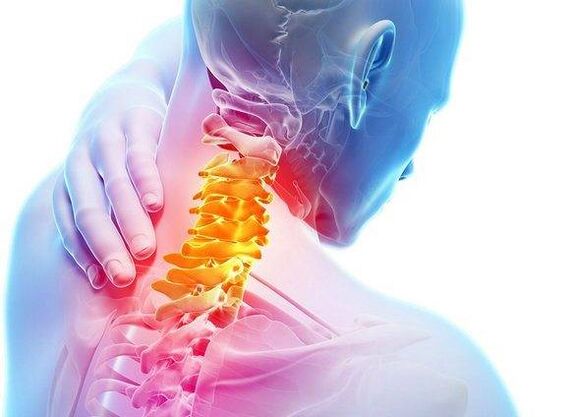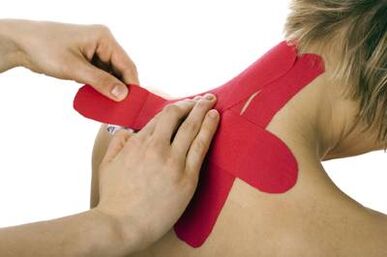A sedentary lifestyle characteristic of office workers and those who like to relax in front of the TV or behind the monitor screen often cause osteochondrosis. In the article we will look at what is osteochondrosis of the cervical spine, the main causes of this disease, its symptoms and stages, methods of treatment, and we will answer other questions that arise in patients with osteochondrosis.

The osteochondrus process affects one of the spine or several at a time. The lumbar and cervical vertebrae are most affected by pathologies, as most susceptible to load due to the anatomy of the human skeleton. The effects of spinal osteochondrosis in the cervical region cause the most discomfort and potential complications, since the neck is a zone rich in neuromusive highways, many of which feed the brain directly. In addition, the nerve roots that ensure the sensitivity and motor activity of the hands and the shoulder girdle, when pressed with destroyed spinal animals, can give a variety of symptomatic picture.
The signs of osteochondrosis of the neck depend on which of the body systems are influenced by the pathology:
- Disconnected circulation due to pressure of the spinal arteries determines most of the symptom complexs of the brain.
- The compression of the roots leaving vertebrates gives a picture of the lesion of the peripheral nerves.
- The pinching of the spinal cerebral areas is associated with severe neurological pathologies found in advanced cases.
Below, think about the General Osteochondrosis Clinic of the cervical spine. Pain in the back of the head, neck and collar. This is the most common symptom. Pain localization can be extended, affecting the shoulders, the area of the clavicle, the chest, the conversion to an intense migraine of the head. The nature of the pain depends on the location of the lesion and the severity of the pathology. At first, the pain can be quickly transient, gradually becoming chronic, sick. At times of exacerbation, the pain becomes firing, with an increased tone of the neck muscles and limited movement of the head. Often pain with cervical osteochondrosis can be localized behind the sternum, in which case many patients take this symptom of angina pectoris.
Noise, ringing, feeling of congestion in the ears
These symptoms often join the hearing reduction. These phenomena are associated with a decrease in blood flow from the spinal arteries to the vestibular apparatus. The complex of these symptoms is called cochlear or snail syndrome and it is far from always possible to determine its relationship with osteochondrosis in the cervical region. A specific characteristic of differentiation is that noise, congestion and ringing in the ears are felt when the position is changed, after a long stay in one position.
Dizziness
Dizziness is also due to a violation of blood flow to the organs of the inner ear, which guarantees the balance of the body. Nystagma often joins dizziness - arbitrary fluctuations in eye students to the countries.
Air
This sensation occurs due to irritation of the edges of the diaphragmatic nerve. It is a component of the cervical nerve beam and is involved in the regulation of breathing, its depth and frequency. Patients complain about the inability to breathe in the full breast. In some cases, the symptom worsens to severe shortness of breath and suffocation. For the same reason, breathing stops at night and snore. The disadvantage of oxygen due to breathing problems is ultimately the cause of increased fatigue, reducing concentration and memory problems.
Nausea
It is accompanied by landing. Also due to blood circulation problems in some areas of the brain and inner ear. Sometimes nausea is observed with unbreakable vomiting provoked by head and body movements. The consequence of frequent nausea and vomiting is a reduction in appetite, weight loss, valuable deficiency.
Vision problems

"Flies" in the eyes, reduction of visual acuity, fog in front of the eyes - these are all symptoms due to ischemia of the brain area responsible for vision. Patients with osteochondrosis complain more than vision, as the lack of blood supply from the vertebrae is offset by the flow of blood from the carbon arteries system. Glasses and therapeutic gymnastics for the eye muscles do not solve the problem, usually vision improves after the treatment of osteochondrosis.
Green symptoms
Often this may be the only sign showing cervical osteochondrosis. They are expressed as sweating, dryness and a lump in the throat, difficulty in swallowing. The symptoms are related to the compression of the nerve plexus responsible for the innervation of the pharynx. It is necessary to distinguish similar manifestations from such a clinic for inflammation or neoplasms.
How to treat osteochondrosis of the uterus
The described condition of the spine is a very serious pathology, which with neglect leads to damage and as a result of deep disorders of cerebral circulation and death. For this reason, by self -self, if such symptoms occur, you should not do. Osteochondrosis is treated at a hospital and at home, exclusively as prescribed by a doctor. In the initial stages, the treatment of cervical osteochondrosis is conservative, which includes recipes for medicines: non -steroidal anti -inflammatory drugs, anesthetics, hormonal drugs, vitamin complexes, chondroprotectors -all this relieves inflammation, pain, improves the trophies of the soft and caritors.
In the acute period, the drugs are prescribed in the form of injections as the pain disappears, the patient goes to tablets. Physiotherapy, massage, exercise for exercise, usually prescribed at the remission stage, join the drug courses. In difficult cases, osteochondrosis is treated with surgery.
Cervical spine diagram
Osteochondrosis of the cervical spine (osteochondrosis) is a degenerative-dystrophic lesions of the intervertebral discs that damage the wheels, vertebrae and joints of the cervical area, reducing the height of the intervertebral discs. The disease progresses if left untreated and can lead to headache, blood disorders and even hernia. Like osteoporosis, the disease occurs due to impaired mineral metabolism, resulting in the bones and joints less durable. Osteochondrosis can cause instability of the cervical spine (symptoms and treatment are similar to chondrosis but have a number of characteristics), which are often accompanied by the displacement of the vertebrae. In turn, this accelerates the development of osteochondrosis, destroying vertebrates.
The main causes that can cause osteochondrosis:
- malnutrition and excess weight;
- Stock disorders, scoliosis, rheumatism, flat legs;
- Study lifestyle: stuck work (drivers, office workers), lack of exercise and more. ;
- neck injuries, spinal injuries;
- Too much physical activity, unusual for the body;
- nervous tension, frequent stress;
- hereditary predisposition to the development of the disease;
- Incorrect development of the cervical spine.

Most of the above causes cause a load of the cervical vertebrae, resulting in muscle spasm. Therefore, the circulation process is impaired, the effectiveness of metabolic processes is reduced, which causes degenerative changes. The structure of the intervertebral discs changes, they are thin and deformed by talking beyond the spine. Often the cause of osteochondrosis is a progressive disc, spread in adjacent vertebrae or bone tissue. It is most commonly found with prolonged physical activity in the lumbar and cervicals, almost never touching the breasts. Development, osteochondrosis goes through several stages, characterized by certain signs and symptoms. We will look at these stages below.
Osteochondrosis of the first degree of cervical region (preclinical stage)
Usually, in the initial stage of the disease, only a slight smoothing of the lordosis of the neck is observed, patients experience pain, enhancing with turns and tilting of the head, feeling tension and rapid fatigue of the muscles in the back and lower back. At this stage, osteochondrosis is cured without medication, it is sufficient to change nutrition, exercise and other events.
Osteochondrosis 2 degrees
In the second stage between the vertebrae there is an instability, the patient begins to disrupt the more intensive pain, which periodically gives him the hands or shoulders, the pain also increases with bends and tilting the head. Patients begin to notice rapid fatigue, absent, reducing the level of efficiency and headache.
Osteochondrosis 3 degrees
At this stage, the pain begins to intensify, it is constantly found not only on the neck but also in the shoulders, giving it to his hands. The muscles of the hand become greater, numbness is observed as the hernia of the intervertebral discs begin to form. In this case, the diagnosis reveals the small mobility of the cervical region. Patients are concerned about dizziness and weakness.
Osteochondrosis 4 degrees
In the last stage, the intervertebral discs are destroyed, which are replaced by connective tissue. The pathological process affects several segments of the ridge at a time, which can be at different stages of destruction. In patients there is a violation of coordination, dizziness and pain intensified, there is noise in the ear and other disorders. Even the initial stage of the disease can be identified according to the following features:
- Headache for osteochondrosis of the cervical region
- neck pain, nape, shoulders or hands;
- Weakness of the hands;
- crunch and pain during head movements;
- General weakness, fatigue, impaired coordination, dizziness;
- Reducing the sharpness of vision and hearing, tingling tongue.

One of the most common signs is dizziness for osteochondrosis of the cervical spine. At the same time, the symptoms of dizziness can be accompanied by noise and ringing in the ears (reduced hearing acuity), sensations of disorientation, migraines, and nausea and vomiting. In addition, the doctor determines how to cure these symptoms, that one should not try to get rid of dizziness with folk methods. Another unpleasant consequence is frequent headache, especially in women. Migraines can occur several times a day, causing unpleasant and painful sensations. The signs of the disease of the cervical region are manifested in a slightly different way than the osteochondrosis of another spine, regarding that the vertebrae in the neck are close to each other, the height of the intervertebral discs is small, leading to complications even with small degenerative changes.
Symptoms of cervical osteochondrosis that occur in the brain
With the development of osteochondrosis, the flow of blood to the brain stem through the arteries, which are compressed by the protruding edges of the vertebrae, decreases. As a result, there is a disorder of the blood circulation of the brain. In patients, neurotic disorders are observed: irritability, anxiety, frequent mood change, resentment, insomnia, the ability to focus is reduced. In some cases, outbreaks of anger, fear, longing may occur. Vascular cramps can lead to fainting, headache, tinnitus, dots in front of the eyes. In this case, the following symptoms of exacerbation appear: dizziness, feeling of instability, nausea, in some cases vomiting.
Treatment of osteochondrosis of the cervical spine
Different methods are used to treat such a disease such as osteochondrosis: medicines, physiotherapy, massage of the cervical brotherly area for blood supply to the brain and therapeutic gymnastics and maintaining proper nutrition. Despite the fact that women are more susceptible to headache and numbness of the limbs in this disease, the treatment of cervical osteochondrosis in women is no different from its treatment in men: it is the same medicines and exercises.
Diagnostic methods
An experienced doctor easily diagnoses cervical osteochondrosis as the disease has a characteristic clinical picture. In order to determine the stage, the patient is prescribed neglect and spread of the pathological process, the patient is prescribed a number of additional examinations:
- Radiography - change in mobility and arrangement of the vertebrae, reduction of intervertebral cracks, determine salt deposits;
- Computed tomography - allows you to see gaps, changes in the height of the disk, the instability of the vertebrae, the compression of the nerve fibers and the spinal cord;
- Magnetic resonance images know you exactly to see pathological changes, to determine the flow of blood and the condition of nerve roots.
Only radiography of the cervical spine is usually sufficient, more expensive methods are used in confusing and unclear cases.

Medical physical education
Cervical osteochondrosis exercises are left to be done strictly during remission, acute phase movements can lead to worsening in the patient's condition. All physiotherapy exercises are reduced to the turns and inclination of the head. It is important to take action slowly, without sudden movements. In case of pain - stop the lesson and seek advice for a specialist.
If a person tends to develop pathology, he or she should periodically attend a specialist and undergo research. This will help identify the disease at an early stage and start treatment on time. For example, cervical osteochondrosis, whose symptoms are described in the article, affect the cervical vertebrae and begin to literally destroy them. What will happen from him is easy to know.


















